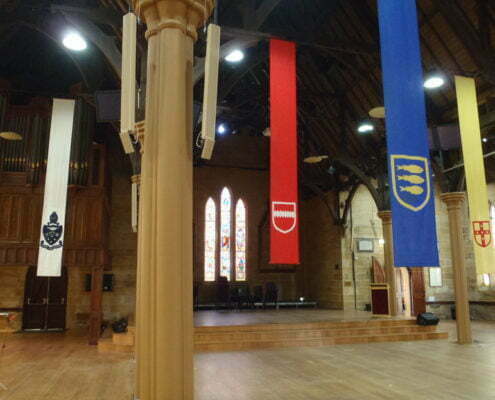About The Venue
In 2011, Acoustic Studio and Gilfillan Soundwork were approached to develop a sound system design for the Great Hall at SCEGGS. The hall is an important space for school assemblies and concerts as well as being hired for external events. A flexible system was required, that met a couple of prime requirements: intelligibility and ease of use.
In order to facilitate an appropriate budget, the system upgrade was divided into two stages: loudspeakers, signal processing and amplification became stage 1, while signal mixing and microphone upgrade was to be stage 2.
The Equipment
Design for stage 1 took into account the fact that the space was completely full during school assemblies and therefore good intelligibility was required for all parts of the room. The Reverberation Time was fairly high – more than 2 seconds at mid frequencies. However, the hall was considered very suitable for musical recitals and the music department did not want to alter the generous acoustic. Luckily there were no particularly troublesome echo effects found. The hall presented quite a challenge for the delivery of good intelligibility: multiple loudspeaker positions were required to achieve coverage, and each loudspeaker was required to maintain pattern control to mid-low frequencies in order to maintain decent direct to reverberant sound ratios at the listener. Maintaining sufficient gain before feedback for lectern microphones and untrained users was also paramount.
Recent advancements in loudspeaker modeling and filtering techniques by a few leading manufacturers have allowed a higher level of optimization to be achieved than was previously possible. These techniques allow a high level of accuracy for directing sound from a loudspeaker system toward audience areas and away from walls and other surfaces. More traditional beam shaping techniques, as used by Acoustic Technologies in the ALA07C loudspeaker, can also achieve excellent results by reducing the amount of sound from a loudspeaker that impinges on walls and ceiling and contributes only to reverberance. A system comprising of Martin omni line loudspeakers for the main left and right, with optimized filtering implemented on a per box basis was chosen, together with 7 x ALA07C-T loudspeakers for delay and fill. This system was integrated to produce very smooth coverage and constant frequency response across the main body of the hall with a useable frequency response extending to 90Hz. The ALA07C-T loudspeakers were processed and amplified by Acoustic Technologies FLA8-DSP.
Further ALA series loudspeakers (ALA04TT) were used to back-fill the stage and under-organ areas.
Measurement results showed that the noiseless STI was in the region of 0.69 in the main nave area, dropping to about 0.60 in the worst aisle areas. This indicates that a very effective audio system is in place in the Hall, and the school is very happy the result: achieved within a reasonable budget in a difficult acoustic space.




